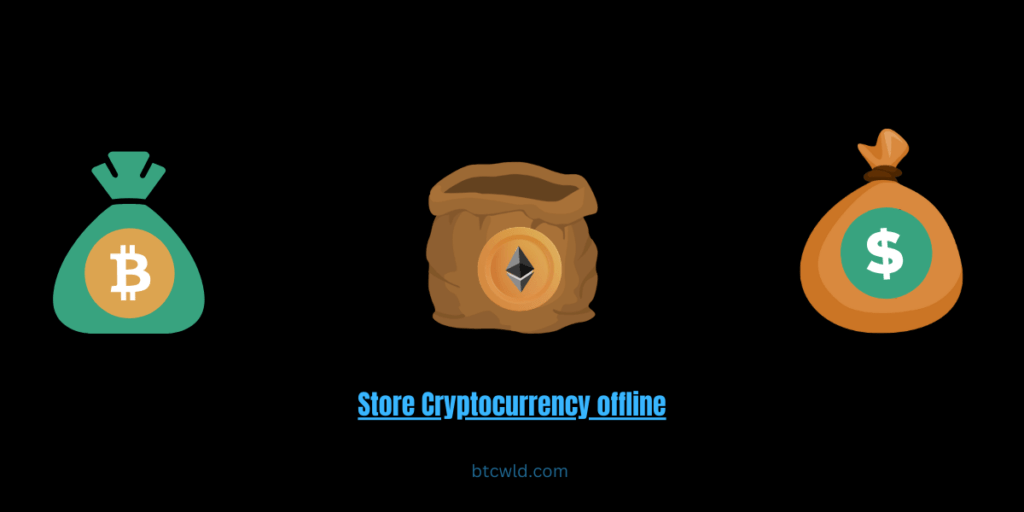Why to store cryptocurrency offline is crucial to understand if you care about your digital assets. Storing the cryptocurrencies as offline holdings makes them much more secure and safe.
Table of Contents
How to store cryptocurrency offline?
Here are the ways you can use to store your cryptocurrencies offline:
Cold Storage (Cold Wallets): These are like traditional storage techniques where the digital assets are stored in wallets which are not connected to the internet. Storing in these wallets, offline and away from the cloud, drastically reduces the potential cyber attacks on these devices. The types of cold wallets are discussed below.

Types of cold storage:
Hardware Wallets: These are small hardware devices like Ledger Nano S which store your private keys securely. They often remain disconnected from the internet when not in use.
USB Drives:
Crypto-assets can be stored on the USB drive as well. It provides you a full control over your funds. When offline, your crypto is immune to cyber-attacks.
Paper Wallets:
Generate a paper wallet with your private key and public address. Keep it physically secure.
External Hard Drives:
Store encrypted wallet files on an external drive that isn’t connected to the internet.
Non-Custodial Wallets:
These are the wallets where the user has the control over his private keys. They do not rely on the third party for safeguarding their keys.
Examples:
Desktop Wallets-
These can be installed on your computer. While not the safest, they provide convenience.
Mobile Wallets:
They are hosted on your mobile device. Not very secure but they are useful for small amounts.
Hardware Wallets:
This is the most secure option for long-term storage.
Web-Based Wallets:
Must use these cautiously as they are accessible online, however, allow you to control your keys.
Smart Practices to store your crypto securely
Backup Your Keys:
Create a backup of your private keys or recovery seed (a list of words). Store it securely offline. You can write it manually on your personnel diary or take out a print out of the keys and put it in your personal documents.
Limit Hot Wallet Exposure:
Keep only that amount of your cryptocurrencies in your hot wallet which you plan to use. Hot wallet means normal wallets likes Binance Spot wallet which you use for frequent trading. The surplus amount, lying in the cold storage, should not be moved to this wallet unnecessarily. Move your holdings from the hot wallet to cold storage when not in use.
Avoid Third-Party Apps:
Remember, anything that stores or enters your keys for you is susceptible to hacking. Be cautious with third-party apps and services on your device.
Please keep in that no storage method is 100 percent secure. However, following the smart practices can significantly improve the safety of your digital currencies.
Keep in mind that no storage method is 100% secure, but following these practices
What is Secure Database that Stores the cryptocurrencies?
What is the method of storing cryptocurrency offline called?
The method of storing cryptocurrency offline is called as cold storage. Cold Storage involves storing your cryptocurrency in a way which does not expose them to the internet. This is done by using the hardware wallets like Ledger Nano X which provide an offline way to crypto storage.
Storing in offline devices enhances the safety of your digital funds by reducing the possibility of online cyber attacks or unauthorized access.
Read TOP 10 AI COINS THAT CAN BOOM IN THIS BULL RUN-DON’T MISS!
How do you store crypto for long term?
There are people who want to invest in the cryptocurrencies for a long term, that is more than 10 years. The immediate question comes, How to store crypto for long term? The solution is using offline storage methods and applying smart practices. They provide the secure way of storing the digital assets for long term. Here we discuss those:
- Cold Storage- It involves the use of hardware wallets for storing. They are offline and secure.
- Paper Wallets- Just print private keys of your wallet and keep that page safe.
- USB Wallets- It uses a USB drive with a wallet software installed in it. It is used only as and when the need arises.
- Air Gapped Computers- Here the keys are generated on a system which had always remained offline.
- Two Factor Authentication-It uses two layers of identity check to access the wallet. For example, you may be asked for a mobile token and email token to successfully log in to the wallet, if you had provided 2FA. It reduces the possibility of unauthorized access to your wallet.
- Whitelisted Addresses-One of the smart practice to safeguard your digital funds is to configure your wallet in a way that allows withdrawals only to the specific addresses. Even if the re is malicioius access, the funds would be safe.
